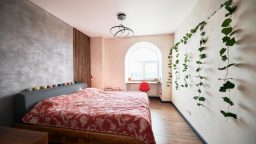Dark colors in home décor can create a bold, dramatic, and luxurious atmosphere. When used thoughtfully, they can transform a space into a cosy retreat or an elegant, sophisticated haven. However, dark shades—whether deep blues, charcoal greys, rich burgundies, or midnight blacks—can overwhelm a room if not incorporated properly. To help you make the most of dark colors in your home, here’s a guide to the dos and don’ts when using these hues in your décor.
- Do Use Dark Colors to Create a Cozy Ambience
Dark colors have the remarkable ability to make a room feel intimate and cosy. They work especially well in spaces where you want to create a warm, inviting atmosphere, such as living rooms, bedrooms, and dining areas.
- Living rooms: Dark hues like navy blue or deep charcoal grey can add richness and warmth to a living room. Pair them with soft textures like plush cushions, throws, and warm lighting to soften the effect and avoid making the space feel too heavy.
- Bedrooms: Deep shades, such as dark plum or navy, are perfect for bedrooms where a calm, restful atmosphere is key. Dark walls combined with soft, layered bedding can create a peaceful, cocoon-like environment for rest and relaxation.
Using dark colors in these areas can promote relaxation and comfort, making the room feel like a welcoming retreat from the world outside.
- Don’t Overwhelm the Space
While dark colors can enhance the mood of a room, using too much of them in one place can make the space feel cramped and suffocating. It’s important to balance dark colors with lighter elements to maintain a sense of openness.
- Don’t paint all the walls dark: If you’re opting for dark-colored walls, consider using it on one accent wall and keeping the other walls lighter. This can help ground the space without making it feel too closed off.
- Don’t use dark colors for all furniture: If your walls are dark, keep your furniture in lighter shades to balance out the heaviness of the room. A mix of dark and light furniture pieces can create a more harmonious and visually appealing contrast.
By striking the right balance between dark and light, you can create a beautiful, inviting space without feeling overwhelmed by the color.
- Do Use Dark Colors for Accents and Statement Pieces
If you’re hesitant about using dark colors on your walls, consider incorporating them through accents and statement pieces. Dark-colored accessories, such as rugs, cushions, curtains, or artwork, can add depth and character to your space without overwhelming the room.
- Accent walls: A feature wall painted in a rich, dark color can create a bold statement without overwhelming the entire room. Complement it with lighter-colored furniture and accessories to keep the space balanced.
- Furniture: Dark furniture, like a deep wood dining table, leather sofa, or black bookshelves, can provide a striking contrast against lighter walls, adding elegance and sophistication to the space.
- Decorative accessories: Introduce dark tones through accessories like lamps, vases, or picture frames. These small touches can add drama and sophistication without making the room feel too heavy.
Dark accents can bring a touch of elegance and depth to your décor while allowing you to maintain a lighter, more open atmosphere.
- Don’t Neglect Lighting
One of the biggest challenges when working with dark colors is ensuring that the room is adequately lit. Dark colors can absorb light, making a space feel dim or gloomy if not paired with proper lighting.
- Don’t skip natural light: When possible, make the most of natural light by positioning your furniture near windows or using sheer curtains that let light in. If your room lacks natural light, use light-colored furnishings or reflective surfaces to brighten up the space.
- Use layered lighting: Incorporate a combination of ambient, task, and accent lighting to illuminate the room and enhance the dark tones. Overhead lights, table lamps, and floor lamps with soft, warm bulbs can help balance the deep shades.
- Consider light-colored furnishings: Complement dark walls or furniture with light-colored rugs, curtains, or throw blankets to keep the room from feeling too dark.
Good lighting helps to bring out the beauty of dark colors and ensures your space doesn’t feel too heavy or confined.
- Do Mix Dark Colors with Textures
Texture is key when working with dark colors. Mixing dark hues with different textures can help prevent the room from feeling flat or one-dimensional. The contrast between textures adds interest and depth, making the space feel more dynamic and inviting.
- Textural contrasts: Pair dark walls with luxurious textures like velvet cushions, silk curtains, or shaggy rugs. These contrasting textures can create an inviting, layered look that enhances the richness of dark colors.
- Wood and metal accents: Pair dark tones with natural materials like wood, leather, and metals to add balance and visual interest. Dark wood furniture, gold accents, or brushed metal lamps can complement dark walls or upholstery beautifully.
Mixing dark colors with different textures helps break up the monotony and adds character to your space.
- Don’t Be Afraid of Bold Combinations
Dark colors don’t have to be limited to subtle tones like navy, charcoal, or black. Don’t shy away from bolder, richer colors like deep emerald green, royal purple, or mustard yellow.
- Bold wall colors: Experiment with dark shades like forest green, burgundy, or navy blue for an unexpected but striking look. These colors can add a unique, dramatic effect when paired with light furnishings or accents.
- Contrasting pairings: Combine dark hues with contrasting or complementary shades for an eye-catching effect. Pair a dark accent wall with mustard yellow throw pillows, or combine deep grey with bright red for a modern, edgy look.
Bold color combinations can add energy and creativity to a room, making it feel more vibrant and dynamic.
- Do Use Dark Colors to Highlight Architectural Features
Dark colors are excellent for highlighting architectural features and adding sophistication to certain areas of a room.
- Highlighting features: Use dark tones to highlight architectural elements such as moldings, fireplaces, or built-in shelves. A dark accent color can make these features stand out and become focal points in the room.
- Dramatic contrasts: Dark colors can also be used to create contrast with lighter architectural elements. For example, a dark wall behind a white-framed door or window can make the frame pop and draw attention to the architectural detail.
By using dark colors to emphasize specific features, you can add a touch of drama and focus to your space.
- Don’t Forget the Room’s Purpose
Finally, keep in mind the function of the room when choosing dark colors. While dark hues can create a cosy and dramatic atmosphere, they may not be suitable for every space.
- Living rooms and bedrooms: Dark colors work beautifully in spaces meant for relaxation and socializing, such as living rooms and bedrooms. They create a comfortable, intimate feel.
- Kitchens and bathrooms: Dark colors can also work in kitchens and bathrooms, but they may feel too heavy if not balanced properly. Consider lighter cabinetry or countertops, or add accents in bright, reflective materials like glass or stainless steel.
By considering the purpose of the room, you can determine the right amount of dark color to use and how to balance it with other elements.
Conclusion
Dark colors in home décor can create a striking, sophisticated atmosphere, but they require careful consideration and balance. By following these dos and don’ts, you can use dark shades in your home to create a space that feels luxurious, welcoming, and comfortable. Whether you’re using dark colors as accents, painting a feature wall, or creating a cozy, dramatic room, dark hues can add depth and personality to your home if used thoughtfully. So go ahead—embrace the boldness of dark colors and make your space uniquely yours!





